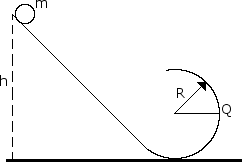Rotational Inertia
A massless string is wrapped around a disk of rotational inertia I = . The disk falls and spins as it falls, unraveling the rope. Determine the tension in the string and the acceleration of the disk.
 SOLUTION MISSING: Unfortunately the author of this youtube video removed their content. You may be able to find a similar problem by checking the other problems in this subject. If you want to contribute, leave a comment with the link to your solution.
SOLUTION MISSING: Unfortunately the author of this youtube video removed their content. You may be able to find a similar problem by checking the other problems in this subject. If you want to contribute, leave a comment with the link to your solution.Related Problems
A flywheel turns through 40 rev as it slows from an angular speed of 1.5 rad/s to stop.
A. Assuming constant angular acceleration find the time for it to come to rest.
B. What is its angular acceleration?
C. How much time is required for it to complete its first 20 of the 40 revolutions?
A solid brass sphere of mass m and radius r << R rolls along a track when released from rest along the straight section. The circular loop has a radius R.

B. Assume the sphere is released at height h = 6.0 R, what are the magnitude and direction of the horizontal force competent acting on the sphere at point Q?
A pulley of radius R1and rotational inertia I1is mounted on an axle with negligible friction. A light cord passing over the pulley has two blocks of mass mattached to either end, as shown below. Assume that the cord does not slip on the pulley. Determine the answers to parts (A) and (B) in terms of m, R1, I1, and fundamental constants.

An explorer plans a mission to place a satellite into a circular orbit around the planet Jupiter, which has a mass of M1= 1.90 x 1027kg and radius R1= 7.14 x 107m. A. If the radius of the planned orbit is R, use Newton’s laws to show each of the following.
The orbital speed of the planned satellite is give by v=
The period of the orbit is given by T=
B. The explorer wants the satellite’s orbit to be synchronized with Jupiter’s rotation. This requires an equatorial orbit whose period equals Jupiter’s rotation period of 9 hr 51 min = 3.55 x 105s. Determine the required orbital radius in meters. C. Suppose that the injection of the satellite into orbit is less than perfect. For an injection velocity that differs form the desired value in each of the following ways, sketch the resulting orbit on the figure. ( J is the center of Jupiter, the dashed circle is the desired orbit, and Pis the injection point.) Also, describe the resulting orbit qualitatively but specifically
When the satellite is at the desired altitude over the equator, its velocity vector has the correct direction, but the speed is slightly faster than the correct speed for a circular orbit of that radius.
When the satellite is at the desired altitude over the equation, its velocity vector has the correct direction but the speed is slightly slower than the correct speed for a circular orbit of that radius.
